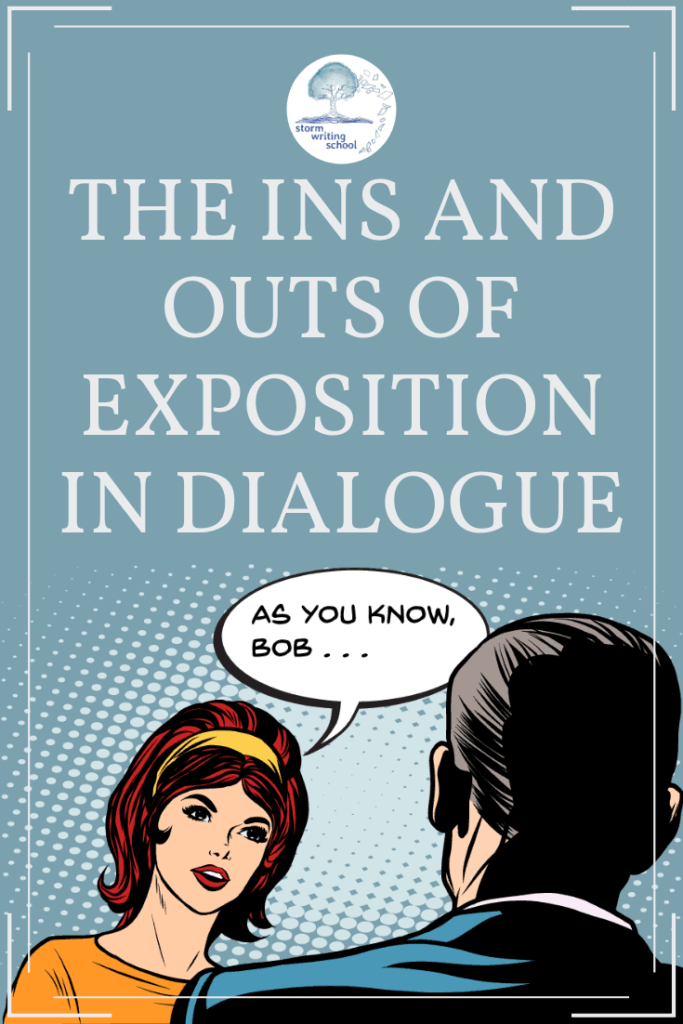According to John Yorke, exposition is “the easiest thing to write badly and the hardest thing to write well.” Yorke is a screenwriter, so he’s talking about delivering exposition through dialogue. We prose writers have narration at our disposal in addition to dialogue. But there are times when we will use dialogue for exposition, so we need to know the pitfalls.
How should you convey exposition? And when can you do it in dialogue?
Exposition ≠ Bad
I want to be clear: exposition is not something to avoid. In fact, stories need exposition.
Exposition provides needed context to get readers relating to characters and feeling the stakes of the conflicts and the worth of the goal.
The main pitfall of narrated exposition is that it can tear readers away from the story, often through the dreaded info dump, which is what happens when a writer interrupts the scene to give us paragraphs worth of information or backstory or description.
Read my article about incorporating exposition via narration for more.
But here, for the remainder of this article, I want to address exposition via dialogue.
The Problem with Exposition via Dialogue
To avoid an info dump, writers sometimes turn to dialogue. There, they figure, the exposition isn’t interrupting the scene.
But they’re wrong.
Exposition-via-dialogue can also tear a reader away from the story. It may not bore them quite as much as a narrational info dump, but it will feel just as—or more—contrived.
Yorke opens his chapter on exposition (in his book Into the Woods) with a passage from a screenplay, in which “Man A” says to Man B, “Isn’t that the Prince Regent, only son of Queen Victoria, heir to the throne and a man whom I’m told consorts with prostitutes, standing over there?”
People don’t talk like that. They don’t say things that are conveniently orienting to anyone happening to eavesdrop.
The Turkey City Lexicon calls such info-dumps-via-dialogue the “As You Know, Bob.”
Narration to the Rescue
The first question to ask of info-dumps-via-dialogue is whether you can/should convey the information in narration instead. The second question to ask is whether you can do so relatively quickly.
If you can narrate some info without disrupting the tension of the scene, then go for it.
Man A can point out the Prince Regent to Man B with a simple “There he is.” And the narration can explain that he’s indicating the Prince Regent standing beside his mother, Queen Victoria.
If the information helps orient the reader succinctly, it will feel natural.
But what of that other information—that stuff about the Prince being heir to the throne and prostitute consort? That may feel gratuitous in narration. Could you get it across via dialogue?
Well, yes. But you need an excuse for the characters to talk about such things.
Keeping Exposition in Dialogue Invisible
The Naive Character
One of the go-to methods for delivering information via dialogue is to make one of the characters naive. If a character within the drama doesn’t know things and wants to know them, then we won’t be dealing with an “As you know, Bob” situation.
Provide a “dramatic imperative for the facts to be explained,” says Yorke, and the audience will accept the spoken information.
For example, when Legasov, the nuclear physicist in Chernobyl, explains to Boris, the government man, how nuclear reactors work, there’s plenty of drama in that situation.
Other times, though, this arrangement can feel like a device. The novice cop with the seasoned pro can work, but it’s definitely a trope that people have seen a lot of. If the reader see your naive character as nothing more than a device for you to deliver exposition, you risk turning off your readers.
Disguise with Desire
But then there are plenty of times when there is no naive character–when they all know whatever exposition you’re trying to get across. As Yorke points out, “Why would a wife, for example, tell her husband he has a potentially fatal illness if it’s something they both already know?”
The answer: desperation.
“For Christ’s sake, see a doctor—it’s cancer!”
Here, the wife’s urgency makes the repetition of this already-known information more plausible. “By showing something is so important it needs to be repeated again, a reason is created” to deliver information.
Which is to say, when a character has an urgent desire, they may reiterate information known to everyone in the interaction.
Disguise with Conflict
Ideally, desire goes hand in hand with conflict. If Man A and Man B are discussing the Prince Regent, the dialogue will be richer with some conflict between them. And that conflict will disguise the exposition. Here’s Yorke’s revision of that interaction:
EXT. STEPS. WESTMINSTER ABBEY
Prince Regent exits Abbey.
MAN A: A fine man.
MAN B: Hardly. He’s a disgrace to his mother.
MAN A: Dare you blacken the Queen’s name?
MAN B: If Victoria knew her Prince Regent was a perpetual client of whores, she’d speak no more highly of him than I.
Emotional Overlay
When conflict and desire enter the interaction, the content of the dialogue has potential for emotional impact. But we can take this even further by adding what Jed Mercurio calls “emotional overlay.” Yorke has us imagine how the above interaction would take on “greater force” if Prince Albert were Man A’s secret lover. The information about the prince consorting with prostitutes might therefore be more emotionally consequential for Man A.
Jed Mercurio writes the following interaction between Mrs. Grey and Doctor Collin, a junior doctor tasked with the goal of conveying to Mrs. Grey that her husband has died.
DR. COLLIN: I wanted to, er … as you know, Albert wasn’t a well man. He had a mesothelioma secondary … he had this kind of … this lung cancer … which came on because he was exposed to asbestos … probably, because he was exposed to … asbestos … you know, you never know for sure … 100 per cent yesterday … he wasn’t a well man … er, we gave him injections … oxygen … nebulizers and I … we did everything we could for him … in the end, there was nothing we could do … actually, if there is anything you want to ask me … er.
MRS GREY: Well, how is Albert now? Is it very bad? Is that what you’re saying?
Here, everything comes together. We have a naive character, we have a clear desire, we have an external conflict in that Mrs. Grey wants to hear something other than what Dr. Collin is telling her, and internal conflict in that Dr. Collin does and doesn’t want to tell the news.
And on top of it all is an emotional overlay in that the information has true emotional consequence for the characters.
The bottom line: exposition needs to have a narrative impact. It needs to affect the drama of the present-time scene. You can deliver exposition through dialogue. It just requires some finesse.
Oh, and by the way, you should totally check out Yorke’s book Into the Woods. I highly recommend.









6 Responses
This is why it’s important to keep reading good literature while writing. When you see practical examples of how other writers handle exposition it will become second nature. Thanks for the great techniques in this article.
Amen! I agree 100%, Naomi! Sometimes, though, I have trouble reading as a writer, so it helps to investigate or to have others point out *how* writers achieve their effects.
I relate to both of the previous comments, that it’s important to keep reading good literature, and that it’s helpful to have a cogent explanation of technique with examples. Thanks, Tim.
I need to practice this more. Am so bad at it. 🙂
Anna from elements of emaginette
Great tips, but my history geek self would have preferred that Yorke used a historically accurate example, or one that was completely made up 🙂